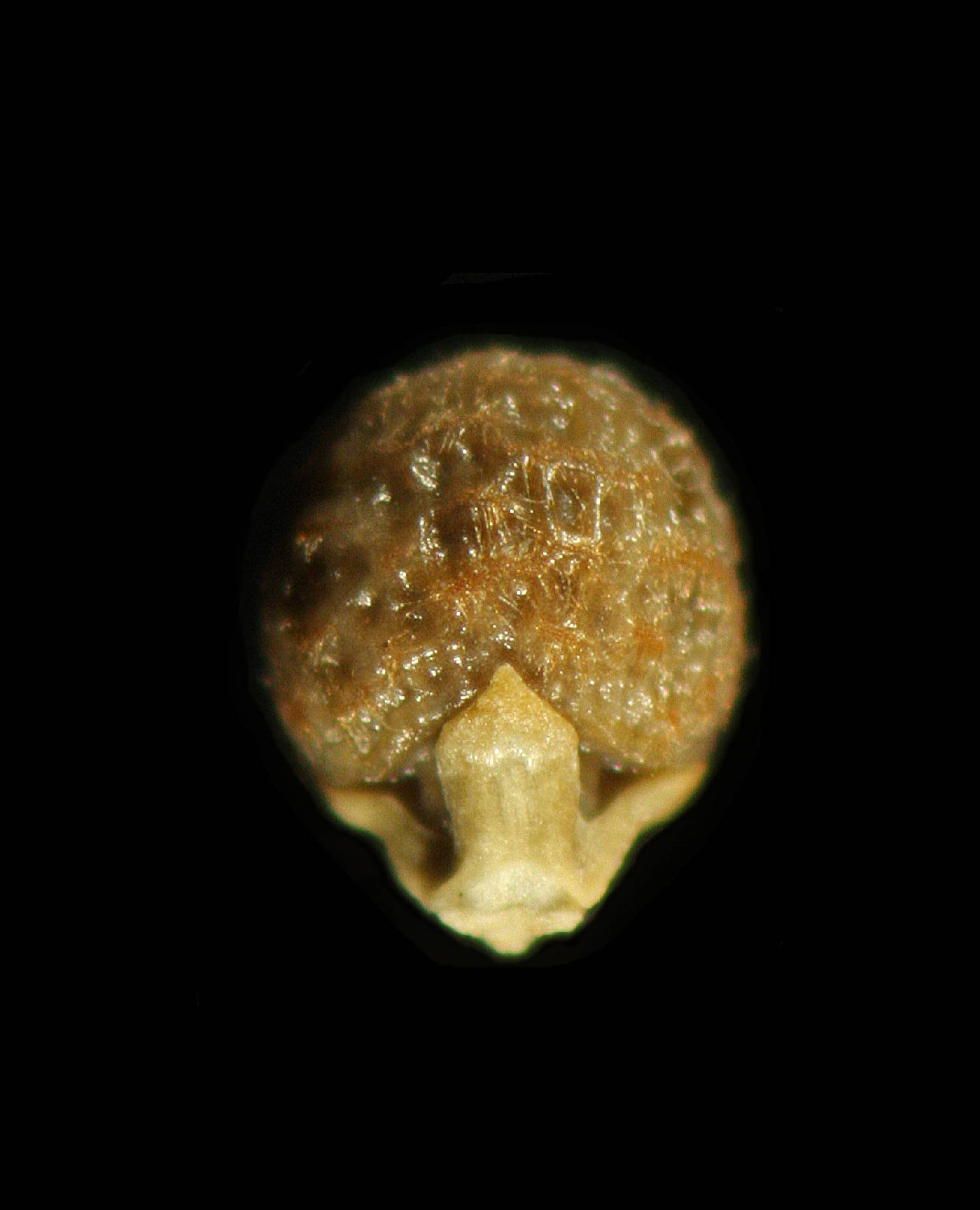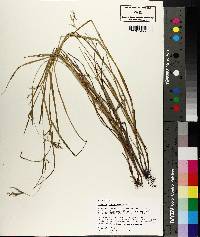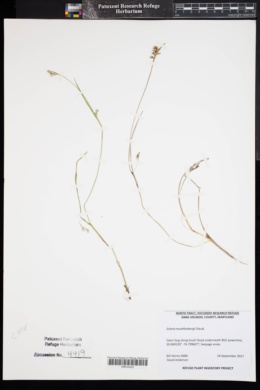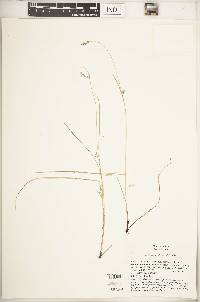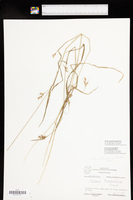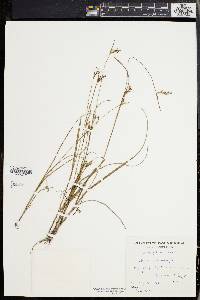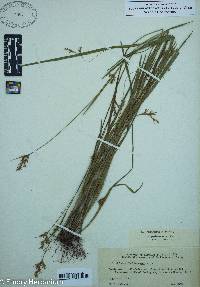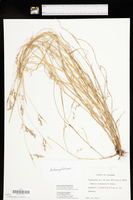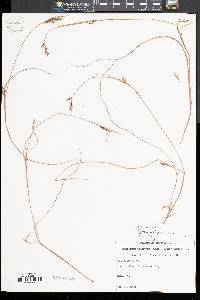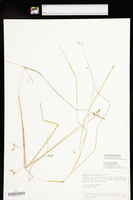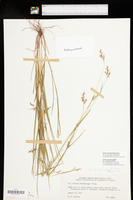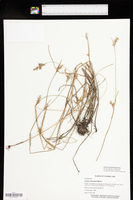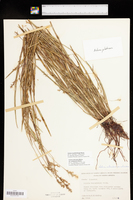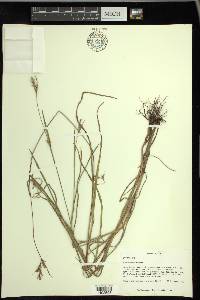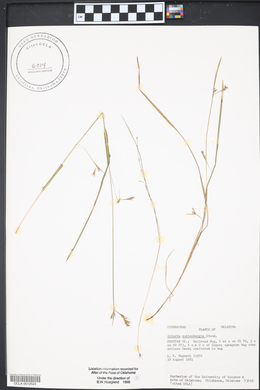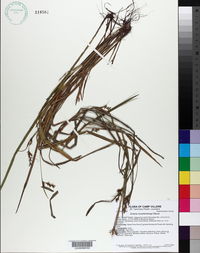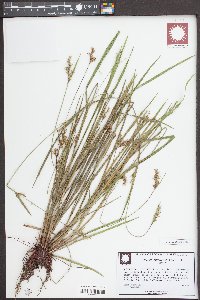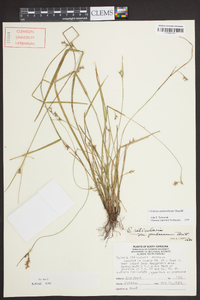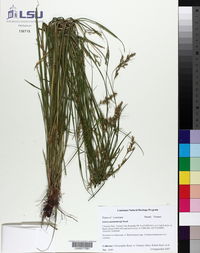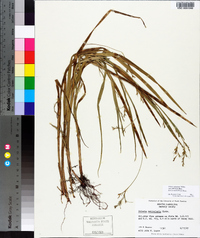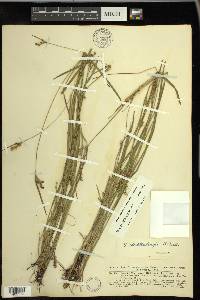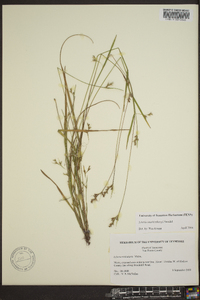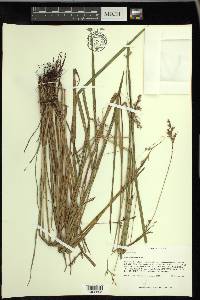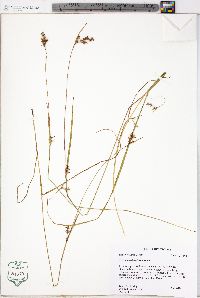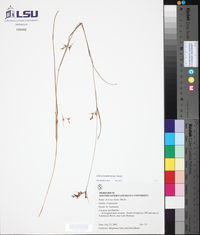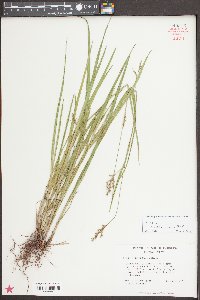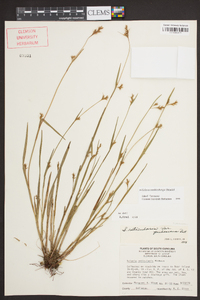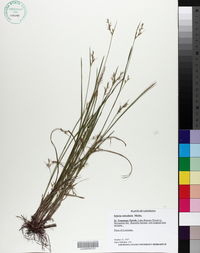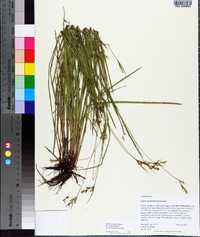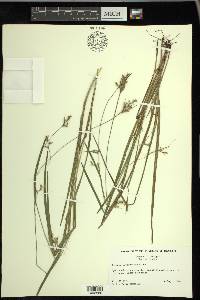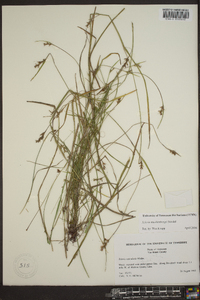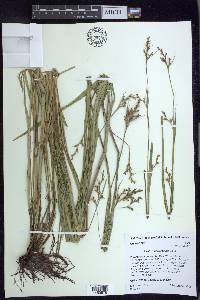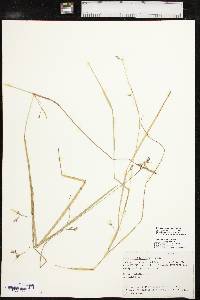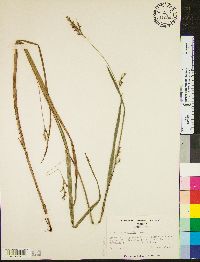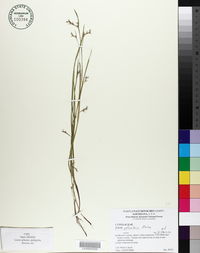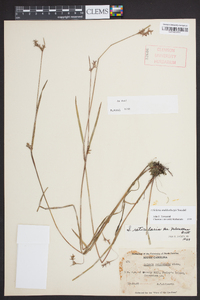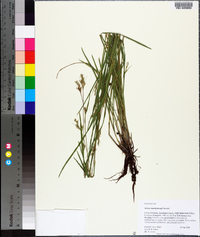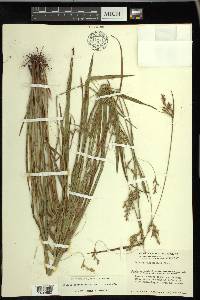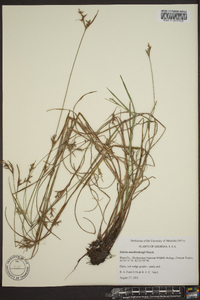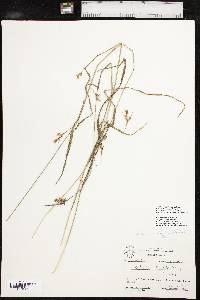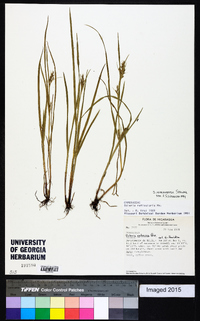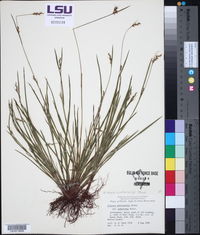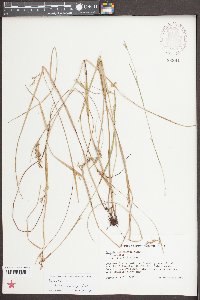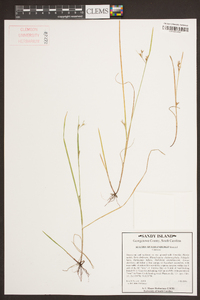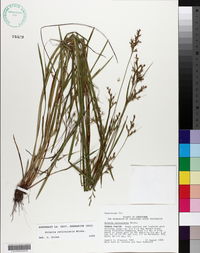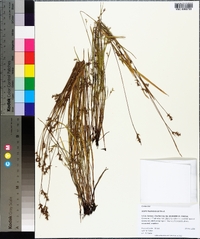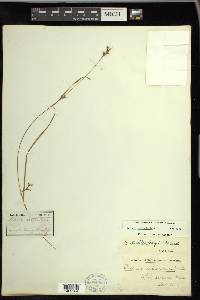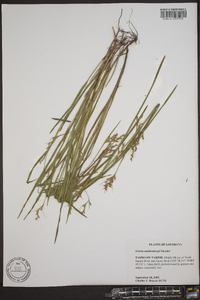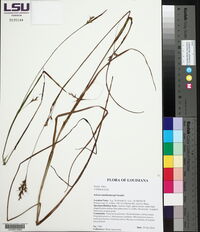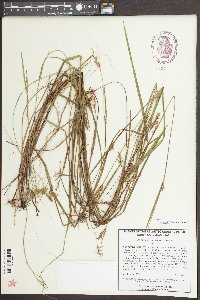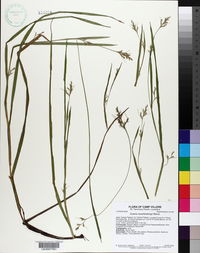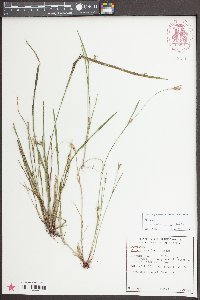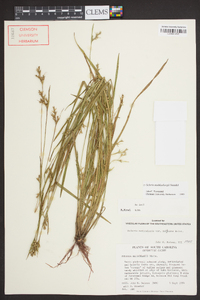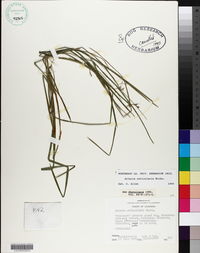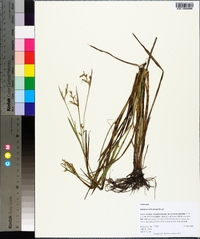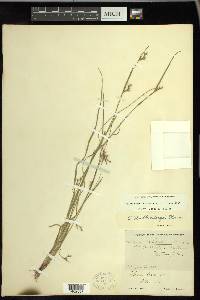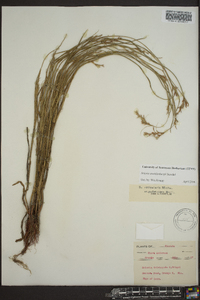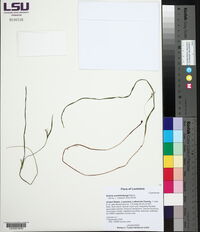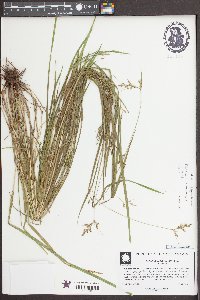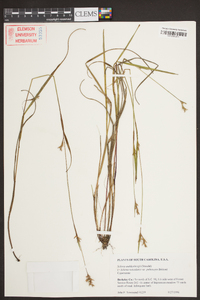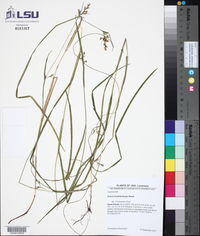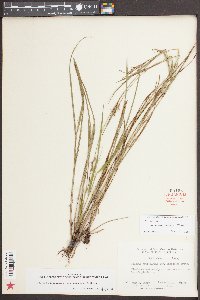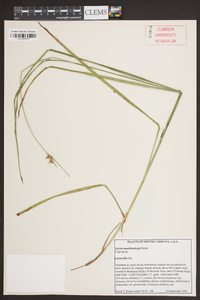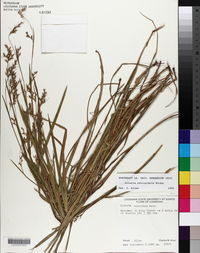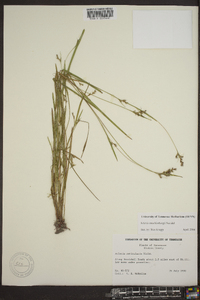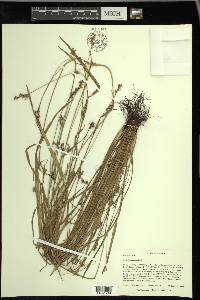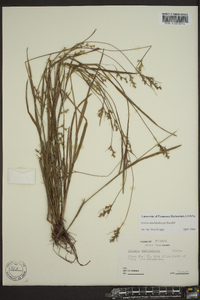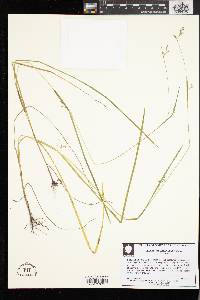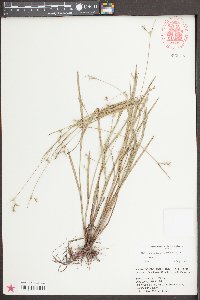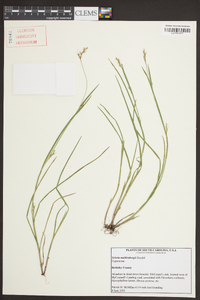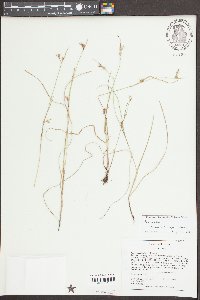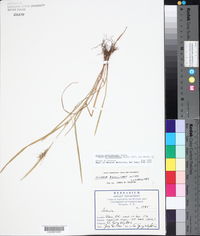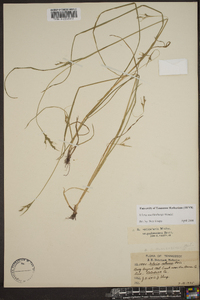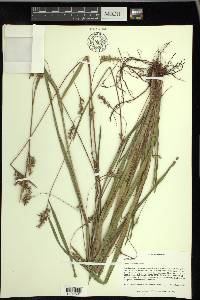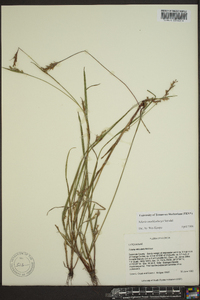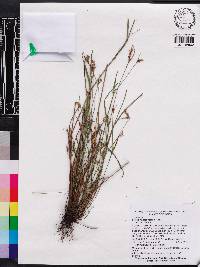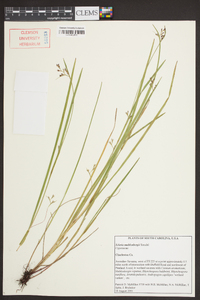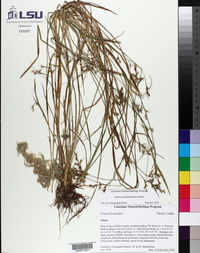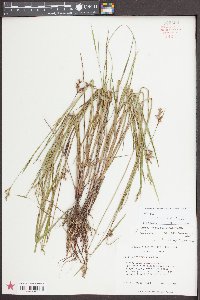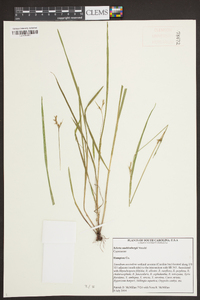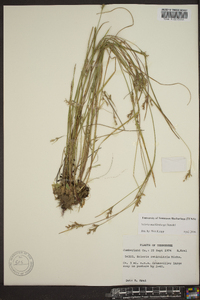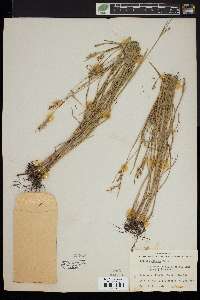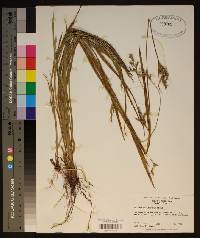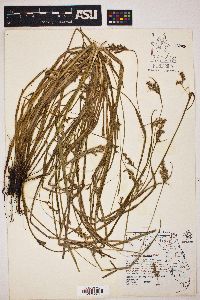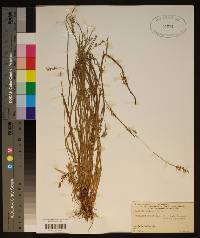Scleria muehlenbergii
|
|
|
|
Family: Cyperaceae
Muehlenberg's Nut-Rush, more...Muehlenberg's nutrush
[Scleria bracteata var. angusta Griseb., moreScleria debilis C.Wright, Scleria dictyocarpa C.Wright ex Griseb., Scleria hemitaphra Steud., Scleria reticularis var. pubescens Britton, Scleria setacea Poir., Scleria stereorrhiza C.Wright ex C.B.Clarke, Scleria stereorrhiza var. major C.B.Clarke, Scleria stevensiana Britton, Scleria torreyana , Scleria trichopoda C.Wright ex Small & Britton] |
Plants annual or sometimes perennial; roots fibrous; rhizomes present in perennial forms, short. Culms solitary or in tufts, erect or spreading, slender, 20-90(-125) cm, glabrous or hairy. Leaves: sheaths often purplish tinged at base, sometimes somewhat winged, ribbed, glabrous or densely pubescent; contra-ligules rotund-obtuse, short; blades linear, flat, often ribbed, obtuse, shorter than or equaling culm, 1-5(-8) mm wide, glabrous or sparsely hirsute, sometimes scabrous on margins and veins abaxially. Inflorescences axillary and terminal, paniculate; panicles diffuse, 15-40(-80) mm, lateral clusters ± remote, the proximal pedunculate, peduncles often recurved or pendulous, filiform, compressed, (15-)20-100 mm; bracts subtending inflorescence leaflike, a bracteal leaf subtending panicles, usually 1/4-3/4 length of terminal internode, margins scabrous. Spikelets bisexual or unisexual; staminate spikelets 2-3 mm, pistillate spikelets 3-4(-5) mm; staminate scales lanceolate, pistillate scales ovate-lanceolate, acuminate. Achenes gray or brownish and/or with dark interangular lines and little pubescence, globose to ovoid, 1-3(-3.5) mm, reticulate to completely smooth, somewhat verrucose in some forms, reticulations smooth or pubescent with tufts of yellowish hairs, apex umbonate; hypogynium distinctly 3-lobed, lobes ovate-lanceolate, obtuse or subacute, sometimes cuspidate, appressed to base of achene. Fruiting summer-fall. Moist to wet (rarely dry) pinelands, savannas, prairies, and bogs: 0-500 m; Ala., Ark., Del., D.C., Fla., Ga., Ill., Ind., La., Md., Miss., Mo., N.J., N.Y., N.C., Okla., Pa., S.C., Tenn., Tex., Va.; Mexico; West Indies; Central America; n South America. Scleria muehlenbergii is uncommon inland from the Coastal Plain, occurring usually in wet places at lower elevations. This complex in Scleria is a difficult one. Recent authors recognized this plant as only a variety of S. reticularis, using the name S. reticularis var. pubescens. Taking all characters into consideration, S. muehlenbergii appears to be geographically, ecologically, and morphologically distinct from S. reticularis in the flora. As recognized here, S. muehlenbergii is quite variable in stature and achene size and sculpturing. In the United States, occasional plants occur with glabrous achenes, and some collections have achenes lacking or almost lacking sculpturing. Those variants maintain other features of S. muehlenbergii. Some tropical collections of the complex appear to be identical to United States material of S. muehlenbergii; other specimens appear somewhat different and combine characteristics in alternative ways. Those plants do not appear to be simple intermediates between S. muehlenbergii and S. reticularis. Plants from the Caribbean appear to be essentially identical to plants from the United States. Specimens of this complex from Mexico and Central America are also similar in most features to S. muehlenbergii, but some western Mexican plants are quite different, as noted by R. McVaugh (1993b), and Mexican and Central American plants usually have longer inflorescence bracts and often less pubescent achenes. More study is clearly needed here. R. McVaugh (1993b) suggested that the oldest name available at varietal rank is Scleria bracteata var. angusta Grisebach. The combination under S. reticularis appears not to have been made.
Annual (sometimes perennial) herb with fibrous roots (or short rhizomes when perennial) 20 cm - 1 m tall Leaves: three-ranked. Sheaths tinged purple basally, occasionally somewhat winged, ribbed, sometimes densely hairy. Ligules short and round. Blades stiff, 1 - 5 mm wide, shorter than or equal to the culm, linear with a blunt tip, flat, often ribbed, midvein prominent, sometimes sparsely hairy. Inflorescence: a small, branched arrangement (panicle) of spikelets, axillary and terminal, subtended by leaf-like bracts. Terminal panicles loosely forking and 1.5 - 4 cm long. Lateral panicles more or less remote, the uppermost bearing a bract (including sheath) one-fourth to three-fourths the length of the terminal internode, the lower growing on recurved or drooping stalks. Stalks thread-like, compressed, 2 - 10 cm long. Flowers: either male or female, borne on the same plant (monoecious), minute, subtended by a floral scale, lacking sepals and petals. Stamens one to three, exserted. Anthers 2 - 4 mm long. Pistil one. Style linear, two- to three-cleft. Fruit: a one-seeded achene, white to dirty gray or brownish, 1 - 3 mm wide, spherical to egg-shaped with an umbonate (bearing an umbo, or protuberance) apex, smooth or wrinkled, often with whitish or tawny hairs on the ridges, sometimes slightly warty, subtended by a disk-like structure (hypogynium). Hypogynium three-lobed. Culm: solitary or forming tufts, spreading or upright, slender, 20 cm - 1 m long, three-sided, solid, sometimes hairy. Spikelets: unisexual. Male spikelets 2 - 3 mm long, with lance-shaped scales. Female spikelets 3 - 4 mm long, with egg- to lance-shaped scales. Similar species: No information at this time. Flowering: late July to mid-August Habitat and ecology: Rare in the Chicago Region, and known only from Jasper and Porter counties in Indiana. There it grows on moist marsh borders. Occurence in the Chicago region: native Etymology: Scleria comes from the Greek word scleria, meaning hardness, referring to the fruit. Muehlenbergii is named in honor of Gotthilf Henry Ernest Muhlenberg (1753-1815), an American botanist. Author: The Morton Arboretum From Flora of Indiana (1940) by Charles C. Deam Indiana Coefficient of Conservatism: C = 10 Wetland Indicator Status: FAC |

